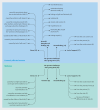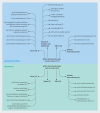From Idea to Implementation: Development of the Smart-e-Moms App to Reduce Postpartum Depressive Symptoms
- PMID: 40771832
- PMCID: PMC12324856
- DOI: 10.1055/a-2553-7247
From Idea to Implementation: Development of the Smart-e-Moms App to Reduce Postpartum Depressive Symptoms
Abstract
Introduction: Postpartum depression is the most common mental health disorder associated with the birth of a child. However, postpartum depression often remains untreated because there are not enough prevention and treatment options. Barriers such as lack of knowledge and fear of stigmatization also make it more difficult for affected women to start treatment. Digital interventions could be an option which might circumvent many of these barriers. This study describes the development process of the smartphone-based intervention Smart-e-Moms which aims to reduce postpartum depressive symptoms.
Material and methods: The app was developed using a participatory and iterative approach. The three steps used for the formative evaluation were: (1) an analysis of needs and preferences (focus groups with 9 formerly affected women and 11 midwives), (2) an analysis of the barriers and facilitating factors to use the app (online survey of 37 mothers), and (3) testing of the app (online interviews with 10 acutely affected women). Qualitative data was analyzed with MAXQDA for content analysis.
Results: Step 1 identified numerous challenges after giving birth such as stress, negative thoughts and feelings, and lack of support, all of which flowed into the contents of the app. Ensuring that the units were short and the topics "self-care" and "relationship to the child" were also considered important. In step 2, barriers and facilitating factors were identified and incorporated into the design of the app. Step 3 consisted of a positive assessment of the first version of the app in terms of content and formal design as well as usability. The final app consisted of 10 behavioral units with written psychological guidance, constantly accessible exercises on self-care and the relationship to the child and permanently available information on common challenges after giving birth.
Conclusion: We present a new and innovative approach which aims to reach out more easily to women with postpartum depressive symptoms. The most important insights from the development process, the final design, and the elements of the program are described here.
Keywords: app; formative evaluation; postpartum depression; smartphone-based intervention.
The Author(s). This is an open access article published by Thieme under the terms of the Creative Commons Attribution-NonDerivative-NonCommercial-License, permitting copying and reproduction so long as the original work is given appropriate credit. Contents may not be used for commercial purposes, or adapted, remixed, transformed or built upon. (https://creativecommons.org/licenses/by-nc-nd/4.0/).
Conflict of interest statement
Conflict of Interest The authors declare that they have no conflict of interest. Interessenkonflikt Die Autorinnen/Autoren geben an, dass kein Interessenkonflikt besteht.
Figures




Similar articles
-
Comparison of self-administered survey questionnaire responses collected using mobile apps versus other methods.Cochrane Database Syst Rev. 2015 Jul 27;2015(7):MR000042. doi: 10.1002/14651858.MR000042.pub2. Cochrane Database Syst Rev. 2015. PMID: 26212714 Free PMC article.
-
A digital intervention to improve mental health and interpersonal resilience for young people who have experienced online sexual abuse: the i-Minds non-randomised feasibility clinical trial and nested qualitative study.Health Soc Care Deliv Res. 2025 Jul;13(28):1-27. doi: 10.3310/THAL8732. Health Soc Care Deliv Res. 2025. PMID: 40754856
-
Sexual Harassment and Prevention Training.2024 Mar 29. In: StatPearls [Internet]. Treasure Island (FL): StatPearls Publishing; 2025 Jan–. 2024 Mar 29. In: StatPearls [Internet]. Treasure Island (FL): StatPearls Publishing; 2025 Jan–. PMID: 36508513 Free Books & Documents.
-
Breastfeeding interventions for preventing postpartum depression.Cochrane Database Syst Rev. 2025 Feb 18;2(2):CD014833. doi: 10.1002/14651858.CD014833.pub2. Cochrane Database Syst Rev. 2025. PMID: 39963955
-
Factors that influence participation in physical activity for people with bipolar disorder: a synthesis of qualitative evidence.Cochrane Database Syst Rev. 2024 Jun 4;6(6):CD013557. doi: 10.1002/14651858.CD013557.pub2. Cochrane Database Syst Rev. 2024. PMID: 38837220 Free PMC article. Review.
References
-
- O’hara MW, Swain AM. Rates and risk of postpartum depression—a meta-analysis. Int Rev Psychiatry. 1996;8:37–54. doi: 10.3109/09540269609037816. - DOI
-
- Döring KJ. Hamburg: Universitätsklinikum Hamburg-Eppendorf; 2021. Postpartale Depression – Versorgungssituation in der hausärztlichen Praxis.
LinkOut - more resources
Full Text Sources

